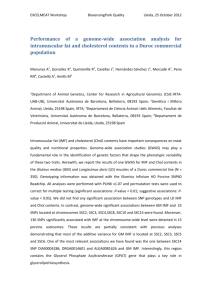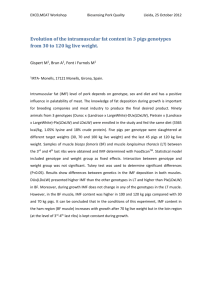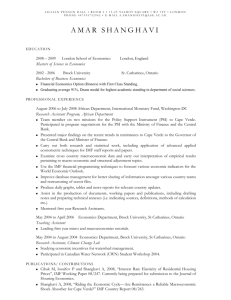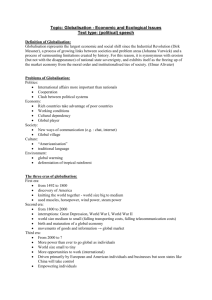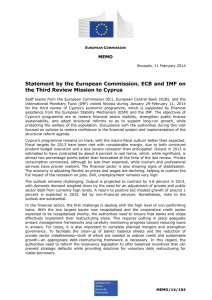Toward a Globalisation with a more human face
advertisement
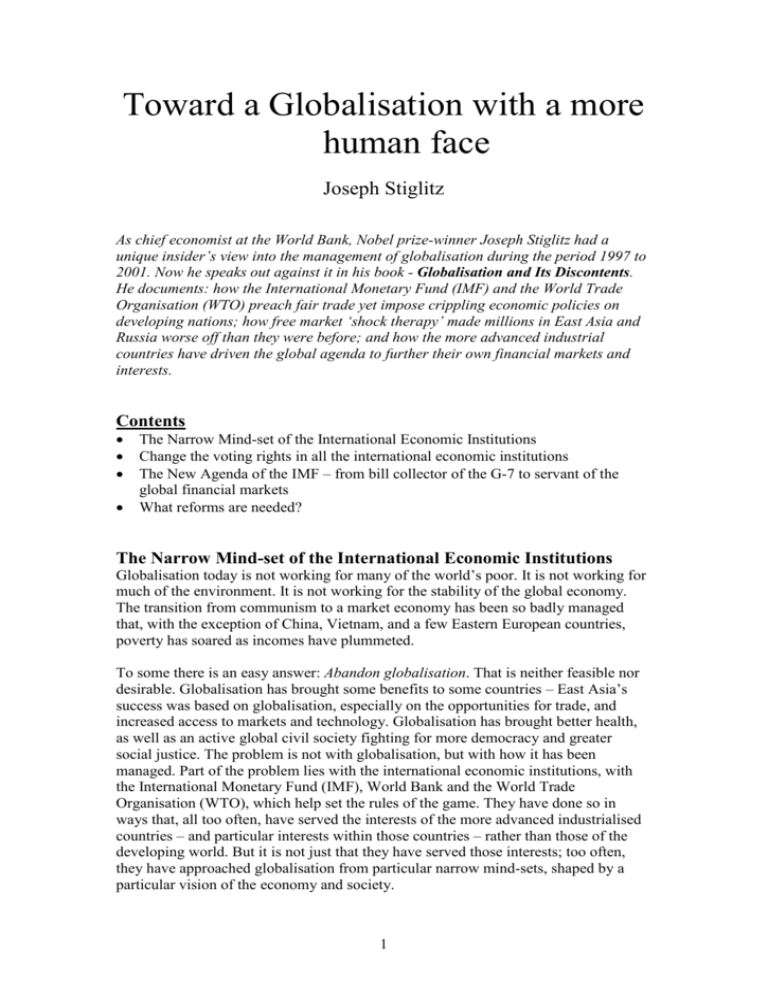
Toward a Globalisation with a more human face Joseph Stiglitz As chief economist at the World Bank, Nobel prize-winner Joseph Stiglitz had a unique insider’s view into the management of globalisation during the period 1997 to 2001. Now he speaks out against it in his book - Globalisation and Its Discontents. He documents: how the International Monetary Fund (IMF) and the World Trade Organisation (WTO) preach fair trade yet impose crippling economic policies on developing nations; how free market ‘shock therapy’ made millions in East Asia and Russia worse off than they were before; and how the more advanced industrial countries have driven the global agenda to further their own financial markets and interests. Contents The Narrow Mind-set of the International Economic Institutions Change the voting rights in all the international economic institutions The New Agenda of the IMF – from bill collector of the G-7 to servant of the global financial markets What reforms are needed? The Narrow Mind-set of the International Economic Institutions Globalisation today is not working for many of the world’s poor. It is not working for much of the environment. It is not working for the stability of the global economy. The transition from communism to a market economy has been so badly managed that, with the exception of China, Vietnam, and a few Eastern European countries, poverty has soared as incomes have plummeted. To some there is an easy answer: Abandon globalisation. That is neither feasible nor desirable. Globalisation has brought some benefits to some countries – East Asia’s success was based on globalisation, especially on the opportunities for trade, and increased access to markets and technology. Globalisation has brought better health, as well as an active global civil society fighting for more democracy and greater social justice. The problem is not with globalisation, but with how it has been managed. Part of the problem lies with the international economic institutions, with the International Monetary Fund (IMF), World Bank and the World Trade Organisation (WTO), which help set the rules of the game. They have done so in ways that, all too often, have served the interests of the more advanced industrialised countries – and particular interests within those countries – rather than those of the developing world. But it is not just that they have served those interests; too often, they have approached globalisation from particular narrow mind-sets, shaped by a particular vision of the economy and society. 1 Change the voting rights in all the international economic institutions The most fundamental change that is required to make globalisation work in the way that it should is a change in governance. This entails, at the IMF and the World Bank, a change in voting rights, and in all of the international economic institutions changes to ensure that it is not just the voices of trade ministers that are heard in the WTO or the voices of the finance ministries and treasuries that are heard at the IMF and World Bank. Such changes are not going to be easy. The United States is unlikely to give up its effective veto at the IMF. The advanced industrial countries are not likely to give up their votes so that developing countries can have more votes. They will even put up specious arguments: voting rights, as in any corporation, are assigned on the basis of capital contributions. China would long ago have been willing to increase its capital contribution, if that was required to give it more voting rights. The former US Treasury Secretary Paul O’Neill has tried to give the impression that it is American taxpayers, its plumbers and carpenters, who pay for the multi-billion-dollar bailouts – and because they pay the costs, they ought to have the vote. But that is wrong. The money comes ultimately from the workers and other taxpayers in the developing countries, for the IMF almost always get repaid. But although change is not easy, it is possible. The changes that the developing countries wrenched from the developed countries in November 2001 as the price for beginning another round of trade negotiations show that, at least in the WTO, there has been a change in bargaining power. The New Agenda of the IMF – from bill collector of the G-7 to servant of the global financial markets The fact that a lack of coherence in the IMF’s approach has led to a multitude of problems is perhaps not surprising. The question is, why the lack of coherence? Why does it persist, on issue after issue, even after the problems are pointed out? Part of the explanation is that the problems that the IMF has to confront are difficult; the world is complex; the IMF’s economists are practical men striving to make hard decisions quickly, rather than academics calmly striving for intellectual coherence and consistency. But I think that there is a more fundamental reason: The IMF is pursuing not just the objectives set out in its original mandate, of enhancing global stability and ensuring that there are funds for countries facing a threat of recession to pursue expansionary policies. It is also pursuing the interests of the financial community. This means the IMF has objectives that are often in conflict with each other. The tension is all the greater because this conflict can’t be brought out into the open: if the new role of the IMF were publicly acknowledged, support for that institution might weaken, and those who have succeeded in changing the mandate almost surely know this. Thus the new mandate had to be clothed in ways that seemed at least 2 superficially consistent with the old. Simplistic free market ideology provided the curtain behind which the real business of the “new” mandate could be transacted. The change in mandate and objectives, while it may have been quiet, was hardly subtle: from serving global economic interests to serving the interests of global finance. Capital market liberalisation may not have contributed to global economic stability, but it did open up vast new markets to Wall Street. What reforms are needed? The recognition of the problems of globalisation has come along way. But the reforms of the international financial system have only just begun. Among the key reforms required are the following: 1. Acceptance of the dangers of capital market liberalisation, and that short-term capital flows (“hot money”) impose huge externalities, costs borne by those not directly party to the transaction (the lenders and borrowers). Whenever there is such large externalities, interventions – including those done through the banking and tax systems – are desirable. Rather than resisting these interventions, the international financial institutions should be directing their efforts to make them work better. 2. Bankruptcy reforms and standstills. The appropriate way of addressing problems when private borrowers cannot repay creditors, whether domestic or foreign, is through bankruptcy, not through an IMF-financial bailout of creditors. What is required is bankruptcy reform that recognises the special nature of bankruptcies that arise out of macroeconomic disturbances; what is needed is a super-Chapter 11 (similar to the approach used in the United States), a bankruptcy provision for the continuation of existing management. Such a reform will have the further advantage of inducing more due diligence on the part of creditors, rather than encouraging the kind of reckless lending that has been so common in the past. Trying to impose more creditor-friendly bankruptcy reforms, taking no note of the special features of macro-induced bankruptcies, is not the answer. Not only does this fail to address the problems of countries in crises; it is a medicine which likely will not take hold – as we have seen so graphically in East Asia, one cannot simply graft the laws of one country onto the customs and norms of another. The problems of defaults on public indebtedness (as in Argentina) are more complicated, but again there needs to be more reliance on bankruptcies and standstills, a point that the IMF too seems belatedly to have accepted. But the IMF cannot play the central role. The IMF is a major creditor, and it is dominated by the creditor countries. A bankruptcy system in which the creditor or his representative is also the bankruptcy judgement will never be accepted as fair. 3. Less reliance on bailouts. With increased use of bankruptcies and standstills, there will be less need for the big bailouts, which failed so frequently, with the money either going to ensure that Western creditors got paid back more than they 3 otherwise would, or that exchange rates were maintained at overvalued levels longer than they otherwise would have been (allowing the rich inside the country to get more of their money out at more favourable terms, but leaving the country more indebted). As we have seen, the bailouts have not failed to work; they have contributed to the problem, by reducing incentives for care in lending, and for covering of exchange risks. 4. Improved banking regulation – both design and implementation – in the developed and the less developed countries alike. Weak bank regulation in developed countries can lead to bad lending practices, an export of instability. While there may be some debate whether the design of the risk-based capital adequacy standards adds to the stability of the financial systems in the developed countries, there is little doubt that it has contributed to global instability, by encouraging short-term lending. Financial sector deregulation and the excessive reliance on capital adequacy standards has been misguided and destabilising; what is required is a broader, less ideological approach to regulation, adapted to the capacities and circumstances of each country. Thailand was right to have restricted speculative real estate lending in the 1980s. It was wrong to encourage the Thais to eliminate these restrictions. There are a number of other restrictions such as speed limits (restrictions on the rate of increase of banks’ assets), which are likely to enhance stability. Yet the reforms cannot, at the same time, lose sight of the broader goals: a safe and sound banking system is important, but it must also be one that supplies capital to finance enterprise and job creation. 5. Improved risk management. Today, countries around the world face enormous risk from the volatility of exchange rates. While the problem is clear, the solution is not. Experts – including those at the IMF – have vacillated in the kinds of exchange-rate systems that they have advocated. They encouraged Argentina to peg its currency to the dollar. After the East Asia crisis, they argued that countries should either have a freely floating exchange rate or a fixed peg. With the disaster in Argentina, this advice is likely to change again. No matter what reforms occur to the exchange rate mechanism, countries will still face enormous risk. Small countries like Thailand buying and selling goods to many countries face a difficult problem, as the exchange rates among the major currencies vary by 50 percent or more. Fixing their exchange rate to one currency will not resolve the problems; it can actually exacerbate fluctuations with respect to other currencies. But there are other dimensions to risk. The Latin American debt crises in the 1980s was brought about by the huge increase in interest rates, a result of Federal Reserve Chairman Paul Volcker’s tight money policy in the United States. Developing countries have to learn to manage these risks, probably by buying insurance against these fluctuations in the in the international capital markets. Unfortunately, today the countries can only buy insurance for short-run fluctuations. Surely the developed countries are much better able to handle these risks than the less developed countries, and they should help develop these insurance markets. It would therefore make sense for the developed countries and the international financial institutions to provide loans to the developing countries in forms that mitigate the risks, e.g. by having creditors absorb the risks of large real interest fluctuations. 6. Improved safety nets. Part of the task of risk management is enhancing the capabilities of the vulnerable within the country to absorb risks. Most developing 4 countries have weak safety nets, including a lack of unemployment insurance programmes. Even in more developed countries, safety nets are weak and inadequate in the two sectors that predominate in developing countries, agriculture and small businesses, so international assistance will be essential if the developing countries are to make substantial strides in improving their safety nets. 7. Improved responses to crises. We have seen the failure of the crisis responses in the 1997–98 crisis. The assistance given was badly designed and poorly implemented. The programmes did not take sufficiently into account the lack of safety nets, that maintaining credit flows was of vital importance, and the collapse in trade between countries would spread the crisis. The policies were based not only on bad forecasts but on a failure to recognise that it is easier to destroy firms than to recreate them, that the damage caused by high interest rates will not be reversed when they are lowered. There needs to be a restoration of balance: the concerns of workers and small businesses have to be balanced with the concerns of creditors; the impacts of policies on domestic capital flight have to balance the seemingly excessive attention currently paid to outside investors. Responses to future financial crises will have to be placed within a social and political context. Apart from the devastation of the riots that happen when crises are mismanaged, capital will not be attracted to countries facing social and political turmoil, and no government, except the most repressive, can control such turmoil, especially when policies are perceived to have been imposed from the outside. Most important, there needs to be a return to basic economic principles; rather than focusing on ephemeral investor psychology, on the unpredictability of confidence, the IMF needs to return to its original mandate of providing funds to restore aggregate demand in countries facing an economic recession. Countries in the developing world repeatedly ask why, when the United States faces a downturn, does it argue for expansionary fiscal and monetary policy, and yet when they face a downturn, just the opposite is insisted upon. As the United States went into a recession in 2001, the debate was not whether there should be a stimulus package, but its design. By now, the lessons of Argentina and East Asia should be clear: confidence will never be restored to economies that remain mired in deep recession. The conditions that the IMF imposes on countries in return for money need not only to be far more narrowly circumscribed but also reflect this perspective. There are other changes that would be desirable: forcing the IMF to disclose the expected poverty and unemployment impact of its programmes would direct its attention to these dimensions. Countries should know the likely consequences of what it recommends. If the Fund systematically errs in its analyses – if, for instance, the increases in poverty are greater than it predicted – it should be held accountable. Questions can be asked: Is there something systematically wrong with its models? Or is it trying to deliberately mislead policy making. Source: Globalisation and Its Discontents, Joseph E. Stiglitz, Penguin Books, London, 2002. price £7.99 Pages: 206-7; 214-15; 226; 236-240. ISBN 0-713-99664-1 5




